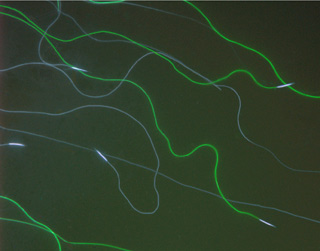
Green fluorescent protein (GFP) expressed in fruit fly sperm cells. (Image by Catherine Fernandez and Jerry Coyne, NIGMS.)
Instructor(s)
Dr. Bluma (Bibi) Lesch
Dr. Renee George
MIT Course Number
7.345
As Taught In
Fall 2014
Level
Undergraduate
Course Description
Course Features
Course Description
Sperm are tiny, haploid cells with a supremely important job: They deliver the paternal genome to the egg, helping create a zygote that develops into a new individual. For a human male, however, only a small fraction of the sperm produced will ever fertilize an egg. Sperm thus experience intense selective pressure: They must compete against each other, navigate a foreign environment in the female reproductive tract, and interact specifically and appropriately with the surface of the egg. These selective pressures can drive extreme changes in morphology and gene function over short evolutionary time scales, resulting in amazing diversity among species. In this course, we will explore the ways in which these unique evolutionary forces contribute to incredible specializations of sperm form and function, including hook-shaped heads and multiple tails. Students will learn from the primary research literature with an emphasis on rigorously interpreting experimental data and critiquing analyses and conclusions.
This course is one of many Advanced Undergraduate Seminars offered by the Biology Department at MIT. These seminars are tailored for students with an interest in using primary research literature to discuss and learn about current biological research in a highly interactive setting. Many instructors of the Advanced Undergraduate Seminars are postdoctoral scientists with a strong interest in teaching.


